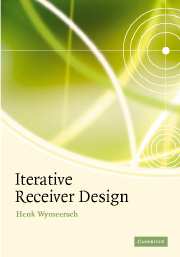Book contents
- Frontmatter
- Contents
- Preface
- Abbreviations
- Notations
- List of algorithms
- 1 Introduction
- 2 Digital communication
- 3 Estimation theory and Monte Carlo techniques
- 4 Factor graphs and the sum–product algorithm
- 5 Statistical inference using factor graphs
- 6 State-space models
- 7 Factor graphs in digital communication
- 8 Decoding
- 9 Demapping
- 10 Equalization–general formulation
- 11 Equalization: single-user, single-antenna communication
- 12 Equalization: multi-antenna communication
- 13 Equalization: multi-user communication
- 14 Synchronization and channel estimation
- 15 Appendices
- References
- Index
4 - Factor graphs and the sum–product algorithm
Published online by Cambridge University Press: 08 January 2010
- Frontmatter
- Contents
- Preface
- Abbreviations
- Notations
- List of algorithms
- 1 Introduction
- 2 Digital communication
- 3 Estimation theory and Monte Carlo techniques
- 4 Factor graphs and the sum–product algorithm
- 5 Statistical inference using factor graphs
- 6 State-space models
- 7 Factor graphs in digital communication
- 8 Decoding
- 9 Demapping
- 10 Equalization–general formulation
- 11 Equalization: single-user, single-antenna communication
- 12 Equalization: multi-antenna communication
- 13 Equalization: multi-user communication
- 14 Synchronization and channel estimation
- 15 Appendices
- References
- Index
Summary
A brief history of factor graphs
Factor graphs are a way to represent graphically the factorization of a function. The sum–product algorithm is an algorithm that computes marginals of that function by passing messages on its factor graph. The term and concept factor graph were originally introduced by Brendan Frey in the late 1990s, as a way to capture structure in statistical inference problems. They form an attractive alternative to Bayesian belief networks and Markov random fields, which have been around for many years. At the same time, factor graphs are strongly linked with coding theory, as a way to represent error-correcting codes graphically. They generalize concepts such Tanner graphs and trellises, which are the usual way to depict codes. The whole idea of seeing a code as a graph can be traced back to 1963, when Robert Gallager described low-density parity-check (LDPC) codes in his visionary PhD thesis at MIT. Although LDPC codes remained largely forgotten until fairly recently, the idea of representing codes on graphs was not, and led to the introduction of the concept trellis some ten years later, as well as Tanner graphs in 1981.
To get an idea of how factor graphs came about, let us take a look at the following timeline. It represents a selection of key contributions in the field.
- Type
- Chapter
- Information
- Iterative Receiver Design , pp. 35 - 76Publisher: Cambridge University PressPrint publication year: 2007



